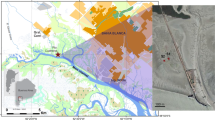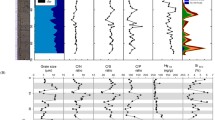Abstract
This paper summarizes the results of a study on the biogeochemistry of two eutrophic marine lagoons. The lagoons investigated were the Bassin d'Arcachon situated on the Atlantic coast, and Étang du Prévost on the Mediterranean coast. The sites chosen for this study were characterized by the presence of dense communities of microphytobenthos. Both lagoons receive a large input of nutrients but they differ in several aspects. The Bassin d'Arcachon receives a large amount of iron. Iron is of great importance in reducing the effects of eutrophication. Ferric iron is an efficient scavenger of phosphate and it has been proposed that this is one of the mechanisms that controls primary productivity and algal growth in this lagoon. The mechanisms of phosphate mobilization were studied by using sediment slurries. These experiments demonstrated that not only ferric iron but presumably also calcium was responsible for phosphate binding. Another effect of the high iron content in the Bassin d'Arcachon was the precipitation of sulfide as iron sulfide or pyrite. In the Étang du Prévost sulfate reduction resulted in the accumulation of free sulfide. The relative low content of iron in Étang du Prévost not only allowed the formation of free sulfide but may also have limited the binding capacity of phosphate in the sediment. On the other hand sulfate reduction was not important for the release of phosphate from the sediment. In Étang du Prévost primary productivity is nitrogen rather than phosphorus limited. In contrast in the Bassin d'Arcachon primary productivity was presumably mostly phosphate limited. In Étang du Prévost the non-heterocystous cyanobacterium Oscillatoria sp. was the dominant nitrogen-fixing species. Heterocystous species were excluded from this lagoon as a result of the presence of free sulfide. It was demonstrated that heterocystous cyanobacteria are more sensitive towards sulfide than non-heterocystous species. The absence of free sulfide explained the presence of the heterocystous cyanobacterium Anabaena sp. in Bassin d'Arcachon.
Similar content being viewed by others
References
Caraco, N. F., J. J. Cole & G. E. Likens, 1989. Evidence for sulphate-controlled phosphorus release from sediments of aquatic systems. Nature 341: 316–318.
Caumette, P., 1986. Phototrophic sulfur bacteria and sulfate-reducing bacteria causing red waters in a shallow brackish coastal lagoon (Prévost Lagoon, France). FEMS Microbiol. Ecol. 38: 113–124.
Cohen, Y., 1989. Photosynthesis in cyanobacterial mats and its relation to the sulfur cycle: a model for microbial sulfur interactions. In Y. Cohen & E. Rosenberg (eds) Microbial mats. Physiological ecology of benthic microbial communities. ASM, Washington: 22–36.
Cohen, Y., B. B. Jorgensen, N. P. Revsbech & R. Poplawski, 1986. Adaptation to hydrogen sulfide of oxygenic and anoxygenic photosynthesis among cyanobacteria. Appl. Envir. Microbiol. 51: 398–407.
Coleman, M. L., D. B. Hedrick, D. R. Lovley, D. C. White & K. Pye, 1993. Reduction of Fe(III) in sediments by sulphate-reducing bacteria. Nature 361: 436–438.
Decho, A. W., 1990. Microbial exopolymer secretions in ocean environments: their role(s) in food webs and marine processes. Oceanogr. Mar. Biol. Annu. Rev. 28: 73–153.
Danenlouwerse, H., L. Lijklema & M. Coenraats, 1993. Iron content of sediment and phosphate adsorption properties. Hydrobiologia 253: 311–317.
Ehrlich, H. L., 1990. Geomicrobiology. Marcel Dekker, New York, 646 pp.
Fay, P., 1992. Oxygen relations of nitrogen fixation in cyanobacteria. Microbiol. Rev. 56: 340–373.
Gallon, J. R., 1992. Reconciling the incompatible: N2 fixation and O2. New Phytol. 122: 571–609.
Gallon, J. R. & L. J. Stal, 1992. N2 fixation in non-heterocystous cyanobacteria: an overview. In E. J. Carpenter, D. G. Capone & J. G. Rueter (eds) Marine pelagic cyanobacteria: Trichodesmium and other diazotrophs. Kluwer Academic Publishers, Dordrecht, NATO ASI Series C. Vol. 362: 115–139.
Haselkorn, R., 1978. Heterocysts. Annu. Rev. Plant Physiol. 29: 319–344.
Hirschler, A., J. Lucas & J.-C. Hubert, 1990. Bacterial involvement in apatite genesis. FEMS Microbiol. Ecol. 73: 211–220.
Howarth, R. W. & S. Merkel, 1984. Pyrite formation and the measurement of sulfate reduction in salt marsh sediments. Limnol. Oceanogr. 29: 598–608.
Howsley, R. & H. W. Pearson, 1979. pH dependent sulphide toxicity to oxygenic photosynthesis in cyanobacteria. FEMS Microbiol. Lett. 6: 287–292.
Lovley, D. R., 1987. Organic matter mineralization with the reduction of ferric iron: a review. Geomicrobiol. J. 5: 375–399.
Lovley, D. R., 1991. Dissimilatory Fe(III) and Mn(IV) reduction. Microbiol. Rev. 55: 259–287.
Lovley, D. R. & E. J. P. Phillips, 1986. Organic matter mineralization with reduction of ferric iron in anaerobic sediments. Appl. Envir. Microbiol. 51: 683–689.
Lovley, D. R. & E. J. P. Phillips, 1987a. Rapid assay for microbially reducible ferric iron in aquatic sediments. Appl. Envir. Microbiol. 53: 1536–1540.
Lovley, D. R. & E. J. Phillips, 1987b. Competitive mechanisms for inhibition of sulfate reduction and methane production in the zone of ferric iron reduction in sediments. Appl. Envir. Microbiol. 53: 2636–2641.
Lovley, D. R. & E. J. P. Phillips, 1988. Novel mode of microbial energy metabolism: organic carbon oxidation coupled to dissimilatory reduction of iron or manganese. Appl. Envir. Microbiol. 54: 1472–1480.
Lovley, D. R., E. J. P. Phillips & F. Caccavo, 1992. Acetate oxidation by dissimilatory Fe(III) reducers. Appl. Envir. Microbiol. 58: 3205–3206.
Oremland, R. S. & D. G. Capone, 1988. Use of ‘specific’ inhibitors in biogeochemistry and microbial ecology. Adv. Microb. Ecol. 10: 285–383.
Oremland, R. S. & S. Polcin, 1982. Methanogenesis and sulfate reduction: competitive and noncompetitive substrates in estuarine sediments. Appl. Envir. Microbiol. 44: 1270–1276.
Pettersson, K., B. Bostrom & O.-S. Jacobsen, 1988. Phosphorus in sediments — speciation and analysis. Hydrobiologia 170: 91–101.
Phillips, E. J. P., D. R. Lovley & E. E. Roden, 1993. Composition of non-microbially reducible Fe(III) in aquatic sediments. Appl. Envir. Microbiol. 59: 2727–2729.
Pugnetti, A., P. Viaroli & I. Ferrari, 1992. Processes leading to dystrophy in a Po River delta lagoon (Sacca Di Goro): phytoplankton-macroalgae interactions. Science Tot. Envir. Suppl. 1992: 445–456.
Reynolds, A. & A. E. Walsby, 1975. Water-blooms. Biol. Rev. 50: 437–481.
Riegman, R., A. A. M. Noordeloos & G. C. Cadee, 1992. Phaeocystis blooms and eutrophication of the continental coastal zones of the North Sea. Mar. Biol. 112: 479–484.
Robertson, B. K. & M. Alexander, 1992. Influence of calcium, iron, and pH on phosphate availability for microbial mineralization of organic chemicals. Appl. Envir. Microbiol. 58: 38–41.
Skyring, G. W., 1987. Sulfate reduction in coastal ecosystems. Geomicrobiol. J. 5: 295–374.
Stal, 1994. Microbial mats in coastal environments. In L. J. Stal & P. Caumette (eds), Microbial mats. Structure, development and environmental significance. NATO ASI Series 35 Springer Verlag, Heidelberg: 21–32.
Stal, 1995. Physiological ecology of cyanobacteria in microbial mats and other communities. New Phytol. 131: 1–32.
Stal, L. J., H. W. Paerl, B. Bebout & M. Villbrandt, 1994. Heterocystous versus non-heterocystous cyanobacteria in microbial mats. In L. J. Stal & P. Caumette (eds), Microbial mats. Structure, development and environmental significance. NATO ASI Series 35 Springer Verlag, Heidelberg: 403–414.
Sukenik, A., W. Schroeder, J. Lauer, G. Shelef & C. J. Soeder, 1985. Coprecipitation of microalgal biomass with calcium and phosphate ions. Water Res. 19: 127–129.
Author information
Authors and Affiliations
Rights and permissions
About this article
Cite this article
Stal, L.J., Behrens, S.B., Villbrandt, M. et al. The biogeochemistry of two eutrophic marine lagoons and its effect on microphytobenthic communities. Hydrobiologia 329, 185–198 (1996). https://doi.org/10.1007/BF00034557
Issue Date:
DOI: https://doi.org/10.1007/BF00034557




